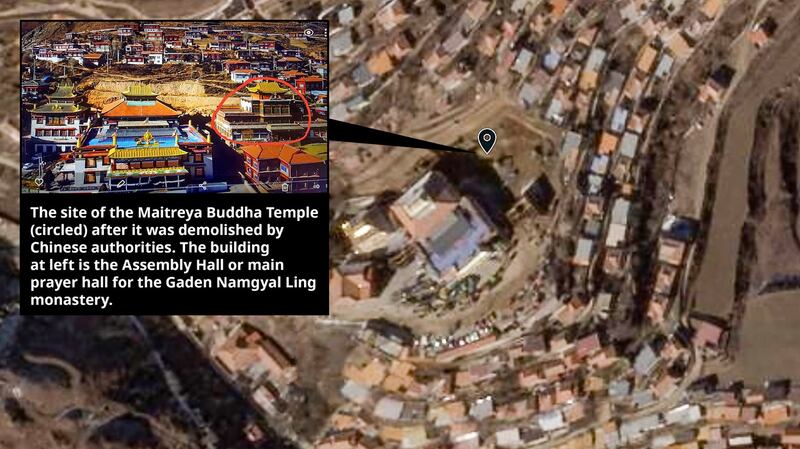RFA has verified the destruction of a second Buddhist statue revered by Tibetans since late last month in western China’s Sichuan province, part of an campaign the ethnic minority says is targeting its religion and traditions.
RFA has analyzed commercial satellite imagery to verify the destruction of a three-story statue of Maitreya Buddha at Gaden Namyal Ling monastery in Drago (in Chinese, Luhuo) county in the Kardze (Ganzi) Tibetan Autonomous Prefecture.
The confirmation of the removal of the statue of Maitreya, believed by Tibetan Buddhists to be a Buddha appearing in a future age, follows RFA's verification last week of the destruction of a 99-foot tall statue 900 meters (2,700 feet) away.
Chinese authorities forced monks from local monasteries and Tibetans living in nearby towns to witness the demolition of the statue and were 45 traditional prayer wheels, which began on Dec. 12 and continued for the next nine days, Tibetan sources in exile said, citing contacts in the area.
The three-story statue and the structure housing it were both torn down around the same time as the 99-foot Buddha, which authorities said was too tall, a Tibetan living in exile told RFA, citing contacts in Drago.
“Chinese authorities have again given unbelievable reasons for the destruction, saying there was no fire escape in the temple housing the three-story high statue of Maitreya Buddha, but these aren’t valid excuses,” the source said, speaking on condition of anonymity to protect his sources in Drago.
“The Chinese government is just continuing to Sinicize Tibet’s religion by not allowing Tibetans the freedom to practice their own religion and faith,” the source said.

Drago county chief Wang Dongsheng had been present at the statue’s destruction and witnessed the brutal police beating of local Tibetans objecting to the demolition, he added, citing local sources.
Wang had also directed the destruction in December of a 99-foot Buddha statue in Drago and had earlier overseen a campaign of destruction of Sichuan’s sprawling Larung Gar Buddhist Academy in a move that saw thousands of monks and nuns expelled and homes destroyed, sources told RFA in an earlier report.
“The brutal attacks on Tibetans still continue in Drago, and sources in Tibet say they have seen Wang Dongsheng taking part in these activities,” a second source in exile told RFA, also asking for anonymity to protect his sources in the region.
Tenzin Lekshey, a spokesperson for Tibet’s Dharamsala, India-based exile government, the Central Tibetan Administration, told RFA that China’s continuing encroachment on Tibetans’ religious freedom will further complicate the troubling issue of China’s rule in Tibetan areas.
“This forceful behavior by the Chinese government in Drago clearly shows the government’s mistreatment of Tibetans and their religion, and the Central Tibetan Administration is very concerned about what is happening in Drago,” he said.
Translated by Tenzin Dickyi for RFA’s Tibetan Service. Written in English by Richard Finney.
